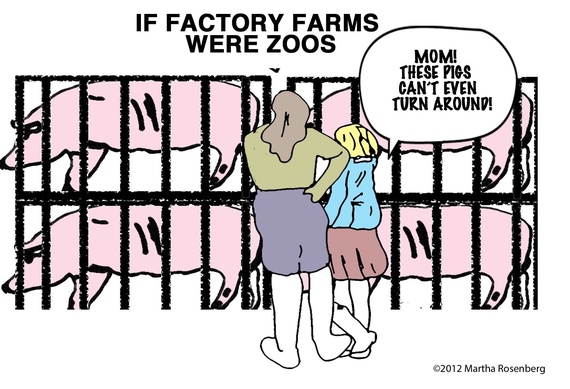Do Cruel Animal Photos Change Your Eating Habits? Many Say No.
Thanks to the Internet, there is no lack of farm verite showing how animals are raised and slaughtered on factory farms. While some people change their eating habits and resolve to not support cruelty, others tune out the images.
Since no one wants to be called "bad" for eating what they were probably raised to eat by their families, many just disregard the disturbing messages. Here are the kinds of things they think and say:
Yeah, yeah -- we know veal calves are taken from their mothers at birth and allowed to freeze to death. We know chickens miss the knife and get boiled alive. We know newborn male chicks are ground up alive at hatcheries. What else is new? The problem is they still taste good the cruelty videos ruin your appetite!
People also want to believe the images they see are the exception, not the rule, though animal welfare groups say they pick factory farms at random and always find shocking cruelty. The ubiquity of cruelty is such a problem, leaders in the meat industry have themselves suggested cameras be put in all barns.
And there's another way people are able to disregard the images. If farm practices are so cruel, they say, why do restaurants, grocers and the government allow them? Aren't there laws?
Of course the same question can be asked about drugs like Vioxx or Xarelto, which are linked to many deaths. If Vioxx or Xarelto are so unsafe, many doctors thought, why would the FDA approve them? Why would doctors prescribe them, thought patients who took the drugs. The answer is that the "law" puts profits before pain whether 50,000 preventable Vioxx-related heart attacks or animals dying in preventable agony.
When it comes to farm cruelty, "Most American consumers are, like me, conflicted," writes the New York Times' Nick Kristof. "We eat meat, but we don't want animals to suffer needlessly." That is why he was shocked at video of chickens abused and legally boiled alive released this week and wrote a scathing column.
Workers grab the birds and shove their legs upside down into metal shackles on a conveyor belt. The chickens are then carried upside down to an electrified bath that is meant to knock them unconscious. The conveyor belt then carries them -- at a pace of more than two chickens per second -- to a circular saw that cuts open their necks so that they bleed to death before they are scalded in hot water and their feathers plucked. Even when the system works as intended, the birds sometimes have legs or wings broken as they are shackled, the investigator said. And when it doesn't work correctly, the birds' end can be horrifying.
What Kristof is referring to is 700,000 chickens boiled alive a year.
This preventable cruelty happens for two reasons. Birds are not covered by USDA humane slaughter laws and the government lets industry speed up its assembly line as fast as it wants in the interests of profit. Both laws could be changed if food consumers told their grocers, restaurants, workplaces and lawmakers that the boiling of chickens alive as seen this week is not acceptable under any circumstances.
